
Figure 1. Comparison of OFDM with Conventional FDM
The Orthogonal Frequency Division Multiplexing (OFDM) technique has become extremely well-liked technique in the last two decades. It is a bandwidth efficient signalling scheme for bandwidth digital communications. The present and upcoming generation of communication system depends mainly on such technique, because of its skill to combat multipath fading channels using the analogous concept of cyclic prefix (Guard Interval).WithOFDM, it is possible to use a differential coding/differential detection either in the time or frequency domain bank on the condition of transmission channels with the adoption of DQPSK as a method of subcarrier modulation. It is crucial to understand the concepts behindOFDM. In whole architecture, the entiremathematicalmanoeuvring occur in transmitter and receiver block i.e. IFFT and FFT block correspondingly. The speed augmentation is the key contribution of the main processing blocks in OFDM system. In this paper, the authors will discuss the basics of OFDM system using 4 sub carriers over the AWGN channel providing DQPSKmodulation. Simulation has been performed on the MATLAB so that, the graphical output will be optimized for interaction and some of its prospective and consequences have been studied.
OFDM was first exemplified in the mid of 1960's. The concept of using parallel data transmission by means of Frequency Division Multiplexing (FDM) was published in 50's. A U.S. patent was filled and issued in 1970. The idea was to use parallel data stream and FDM with overlapping sub bands to avoid the use of high speed equalization and to combat impulsive noise, and multipath distortion as well as to fully use the available bandwidth [1,2]. OFDM increases the spectral efficiency by exploiting sub bands, in comparison with conventional FDM as shown in Figure1. The sub bands are mutually independent in case to avoid any interference. As long as orthogonality maintained, it is still possible to recover the individual subcarrier signals despite their overlapping spectrum. Various fast modems were developed for telephone networks and OFDM has been studied for high speed modems, digital mobile communication and high-density recording in 1980's. In 1990's, OFDM has been expanded for wideband data communications over mobile radio FM channels, digital audio broadcasting and HDTV terrestrial broadcasting high bit rate digital subscriber line (HDSL, 1.6 Mb/s), Asymmetric Digital Subscriber Lines (ADSL, 1,536 Mb/s). The present day phenomenon of increased thirst for large information and the volatile growth of innovative multimedia wireless applications have caused an increased requirement for technologies, which sustain extremely high speed transmission rates, mobility and proficient exploit the available spectrum and network resources [3].

Figure 1. Comparison of OFDM with Conventional FDM
In OFDM, it is very essential to maintain orthogonality among all the subcarrier, otherwise ICI will occur and lead to performance degradation. The aim of wireless communication system such as, an OFDM system is to maintain the orthogonality and low complexity. OFDM system counter the effect of frequency selective fading by splitting the wide transmission band into narrow multiple sub bands. Frequency selective fading is the result of multipath propagation, wherein multiple replicas of transmitting signals traveling down different paths unite at the receiver. In order to oppose the frequency selective fading, all sub bands should be narrow enough so that the bandwidth B satisfies equation 1 [4].

where γav is the average delay spread. OFDM suffers from inter symbol and inter channel interferences. The problems can be abridged considerably by introducing a guard interval in between the ODFM symbols. The guard interval is a cyclic extension of the signal itself couples at the beginning of the OFDM symbol and is called as cyclic prefix [5]. However, some other challenging issues still remain unresolved. Among them, one of the major drawbacks is the high peak to average ratio of transmitted OFDM, which makes power efficiency and system performance poor.
Random binary digits are generated and modulated, that converts data by changing the phase. This serial modulated data is converted to parallel data. The data is then followed by an Inverse Fast Fourier Transform, which is preceded by cyclic prefix at the transmitter end as shown in Figure 2. Cyclic prefix length should be equal to or greater than to the Channel Impulse Response (CIR) memory. A Fast Fourier Transform is performed at the receiver for its efficient implementation.
There are number of modulation techniques used in the transmission of data over longer distances. Modulation is a technique in which, the signal wave is transformed in order to send it over the communication channel in order to reduce the effect of noise to certify that, the received data can be demodulated to get back the original data. Modulation technique can be analog as well as digital, depending upon the type of data transmission. For digital data transmission, BPSK, QPSK, Mary, DQPSK phase shift keying can be used. In this OFDM process, DQPSK have been used for modulation. Differential Quaternary Phase Shift Keying (DQPSK) method enables a high spectral efficiency [6]. DQPSK provides a promising alternative as it, like QPSK, transmits 2 bit per symbol, hence the symbol rate is half the bit rate with reduced complexity of the system, size and high power consumptions. The symbol information is encoded as the phase change from one symbol period to the next rather than as an absolute phase at the transmitter. The receiver has to detect phase changes and not the absolute value of the phase, which avoids the need for synchronized local carrier. Following this, IFFT is executed on the modulated signal, which is further processed by passing through a parallel – to – serial converter. In order to evade ISI, a cyclic prefix to the signal was implemented.
This convertor converts the serial bit stream into many parallel bit stream in such a way that, they are divided among the subcarriers. The benefits of sub carrier is that, they optimally use frequency spectrum, but at the cost of additional processing at the transmitter and receiver. At the receiver side, parallel to serial conversion stage sums up the entire sub carrier and combine them into a signal. After this, IFFT is being executed to reduce the Computational complexity.
Initially, carrier banks were used for generating the brunch of sub carriers, but this approach made the system bulky and costlier. To make the system digital, simple, cheap and efficient, IFFT and FFT are used and a stepwise implementation of butterfly structure is done in this algorithm. These FFT techniques are less complex in implementation as there is no increase in the number of calculations. IFFT is an appropriate choice to use transmitter, which can be used for converting the frequency domain to time domain samples as OFDM is in a time domain [7].


Here, xp and xp are FFT and IFFT equations of OFDM and N is the number of sub carriers.
In presence of orthogonality, there still exists some interference between the subcarriers, due to multipath propagation. To avoid this, Cyclic Prefix (CP) is done between each symbol period to avoid ICI. The CP cyclically extends the symbol period by copying the some portion of each symbol and inserting at the beginning of each symbol as shown in Figure 3. This helps in decoding the received signal even after the signal is detected after some delay spread [8].

Figure 3. Insertion of Cyclic Prefix
Cyclic prefix has two vital points,
1) It acts as a guard interval and eliminates the inter- symbol interference from the previous symbol.
2) It allows only frequency domain processing such as, channel estimate and equalization.
The orthogonality property helps the subcarriers from interference with adjacent subcarriers. If the integral product of two signals is zero over the time period, then two signals are orthogonal to each other [9]. Orthogonality can be defined as follows.
Continuous Time:

Discrete Time:

For orthogonality, the transmitter and receiver must be perfectly synchronized i.e. same modulation technique should be used at both ends. And there should be no multipath channel.
For effective communication between the transmitter and the receiver, there are various channel such as frequency selective fading channels and noisy channel. Here, AWGN noise is considered in this paper. It is a noise that affects the transmitted signal when it passes through the channel [10]. It contains a uniform continuous frequency spectrum over a particular frequency band.
The OFDM process have been shown through graph in the stepwise Figures (4-14) using MATLAB software using these parameters Table 1.

Table 1. Simulation Parameters

Figure 4. Random Data

Figure 5. DQPSK Modulation

Figure 6. Four Subcarriers
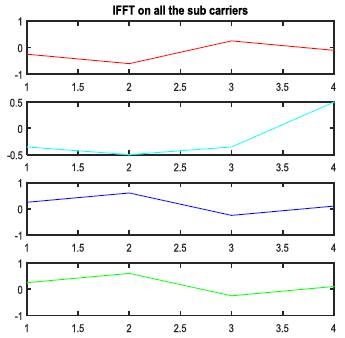
Figure 7. IFFT of all Sub carriers
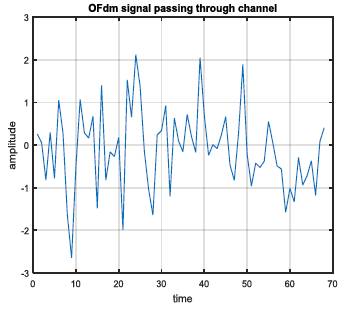
Figure 8. OFDM Signal Passing through the channel
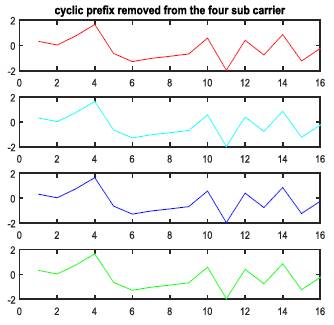
Figure 9. Cyclic Prefix Removed
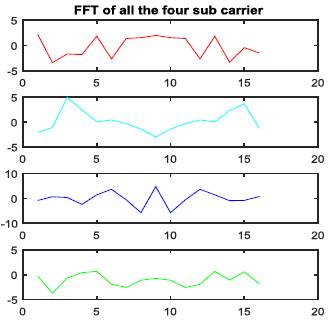
Figure 10. FFT of Sub carriers
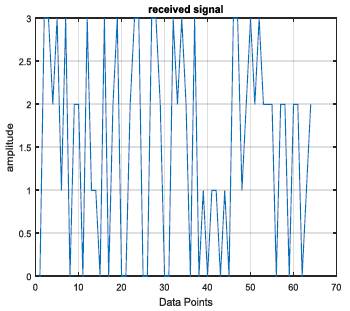
Figure 11. Received Signal
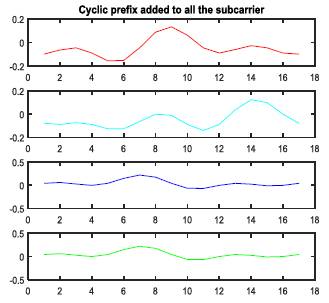
Figure 12. Cyclic Prefix Added
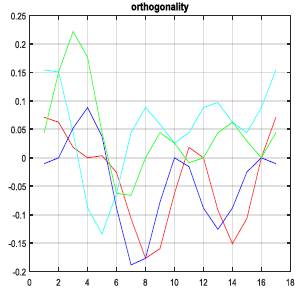
Figure 13. Orthogonality
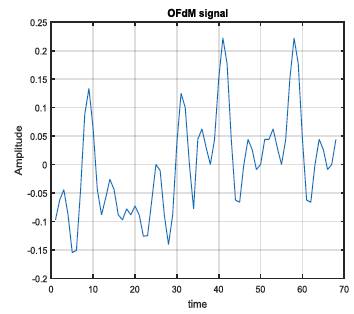
Figure 14. OFDM Signal
The conclusion have been drawn from the above simulation that, OFDM system for wireless communication is most proficient technique of this era. This system curtails the effect of ISI and ICI as compared to single carrier system. OFDM is a multicarrier system, so it also diminishes the impact of multipath fading. This system has been designed using 4 subcarrier with DQPSK modulation. Since, the provided channel is AWGN. Here DQPSK enables the high spectral efficiency. It is computationally efficient due to the use of FFT & IFFT technique to implement modulation and demodulation functions, which makes OFDM superior system for next generation of wireless communication